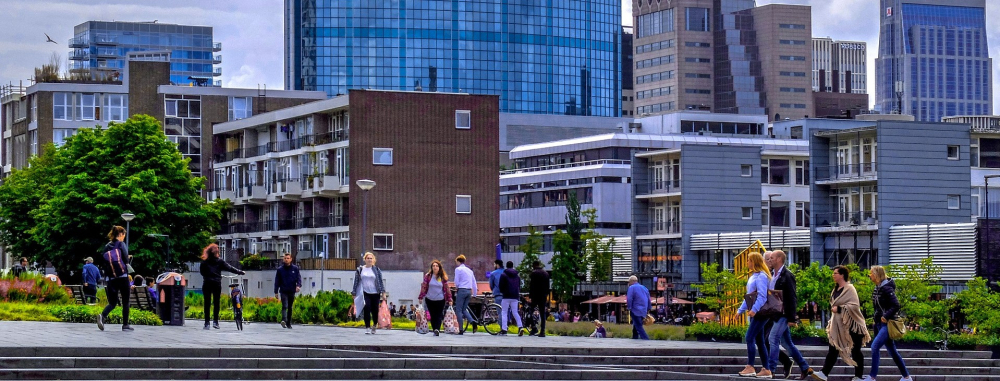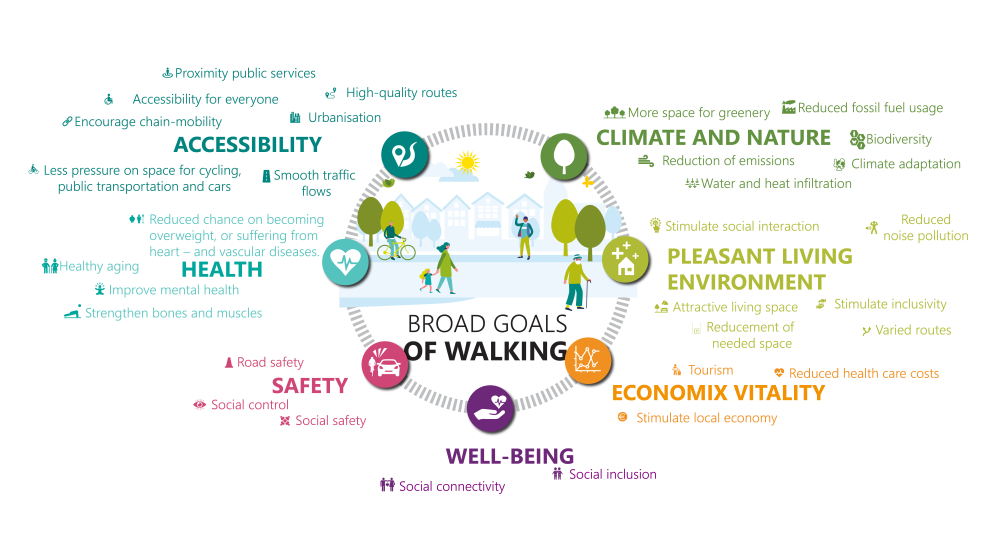Pedestrians
The pressure on our cities is increasing: more people, more homes, more facilities and more space for mobility. This calls for a new approach to public space and pedestrians can play an important role here. But what does the pedestrian need in order to seize these opportunities? Isn't a simple footpath enough for the pedestrian? And what role does data play in the development of pedestrian policies? We will try to answer these questions for you and take you along on the latest developments on the (foot) path of 'the pedestrian'.

Investing in walking pays off
We are all pedestrians. Whether you walk to the bus stop, from the car park to the shop or make the entire journey on foot. And all that walking pays off, because...
... walking improves accessibility
... walking improves health
... safety is increased by walking
... well-being is increased by walking
... walking leads to economic growth
... walking creates a pleasant living environment
... walking is good for the climate and nature
Walking does not only contribute to our individual goals, such as exercising and staying healthy, but it also helps to achieve social goals, such as less fossil fuels. Many of the goals that running contributes to are shown in the visual below. Next, we tell you more about our vision of the pedestrian and what the benefits are for you as a person or organisation.

Our vision: 'Pedestrians first in public space!
In the Netherlands we have an enormous housing challenge. Almost 1 million homes will have to be built by 2030 in order to meet that need. In many cases, these houses will be built in (inner) urban areas. As a result, densification is increasing and the pressure on public space is growing. This is exactly where the opportunities for pedestrians lie. Densification means that more functions and facilities are available within walking distance in neighbourhoods and districts. This makes it easier and more attractive to travel from A to B on foot.
It is therefore essential to invest in walking, because it is impossible to provide space for cars for all the extra housing that will be built. The construction of parking spaces is limited where possible and there is no room to expand existing road infrastructure in inner cities. When designing new urban development plans, pedestrians should therefore come first. At Goudappel, we work with the following order:
- Walking
- Cycling
- Public Transport
- Mobility as a Service
- Cars
At Goudappel we believe that investing in the pedestrian is not only good for the individual, but also for society. That is why we see walking as an integral part of mobility in our cities. As a connecting factor, walking can improve accessibility, enhance health, create safety, increase wellbeing, grow the economy, generate a pleasant living environment for everyone and contribute to climate and nature objectives.
This is why Goudappel puts the pedestrian first in public space.
Integral view of the future
Sustainable mobility, including walking, is important for the future of our cities. Walking and running in cities still do not receive sufficient attention everywhere, while this modality is an important part of sustainable cities. That is why Goudappel is focusing on acquiring additional information about pedestrians, so that we can provide an integrated view of the future in our recommendations. We do this by carrying out research, collecting data and translating these insights into models and practice.
In recent years, for instance, we have conducted several bicycle experience studies to enrich our data on cycling. We also focus on pedestrian experience research, because the pedestrian experience aspect is still underexposed.
We combine data from experience research with travel data from, for example, the Dutch Travel Panel. Based on these data, we can make thorough statements about the experience of certain routes in cities and we can make quantitative statements about pedestrian movements.
In order to get a complete picture of pedestrian movements, we are working on the development of the Vissim pedestrian model with the module VisWalk. With this model we can model pedestrian flows and visualise for example queues and bottlenecks on the footpath.
